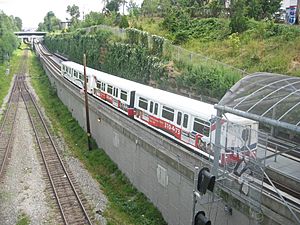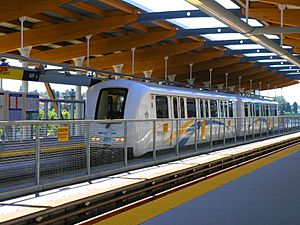History of the SkyTrain facts for kids
The SkyTrain is a fast public transportation system in Metro Vancouver, Canada. It was first planned as a special project for Expo 86, a big world fair held in Vancouver. The very first SkyTrain line was ready just in time for the fair, showing off its theme: "Transportation and Communication: World in Motion – World in Touch." The government helped pay for its construction.
Even back in the 1950s, Vancouver thought about building a monorail system. But that idea didn't happen. By the 1970s, Vancouver had big traffic problems because there wasn't a good public transit system. At the same time, a company in Ontario called the Urban Transportation Development Corporation was creating a new transit technology. It was called "Intermediate Capacity Transit System." In 1980, Vancouver really needed a transit system, and Ontario needed buyers for its new technology. So, Vancouver chose this "Advanced Rapid Transit" system to be built and shown off at Expo 86.
Contents
Building the First SkyTrain Line (Expo Line)
Construction of the first SkyTrain line began on March 1, 1982. Bill Bennett, who was the leader of the Social Credit government at the time, officially opened the system at Waterfront Station.
The SkyTrain opened its doors on December 11, 1985, offering free rides on weekends. It started full service on January 3, 1986.
Expanding the Expo Line
At first, the SkyTrain only went as far as New Westminster Station. But in 1987, work began to make the line longer. This extension included the Skybridge, Columbia Station, and Scott Road Station. This allowed the SkyTrain to reach Surrey.
The line grew even more in 1994. New stations like Gateway, Surrey Central, and King George were opened. The SkyTrain is an important part of the 1996 plan for the Greater Vancouver Regional District (GVRD). This plan helps deal with the growing population by offering more ways to travel and encouraging people to use public transit.
Planning for New Lines
From 1989 to 1993, BC Transit studied how to build a rapid transit line from Vancouver to Richmond. They looked at many different routes in Vancouver, like Granville and Cambie streets. In the end, a SkyTrain line along Cambie Street was chosen as the best option.
However, around 1995, the government changed its plans. They announced a new rapid transit route that would go from Broadway to Lougheed and New Westminster. This new line would be called the Millennium Line. They also mentioned future lines to Coquitlam and Richmond.
SkyTrain Grows Bigger
In 1997, talks started about who would be in charge of SkyTrain. The goal was to move control from the province to local governments. This happened in 1999 when the Greater Vancouver Transportation Authority Act was passed. This act created TransLink, which took over the SkyTrain system.
TransLink and the province agreed on a plan for limited growth. The province would handle big expansions through a company called Rapid Transit Project 2000 Ltd. (RTP 2000).
The Millennium Line
As Metro Vancouver kept growing, TransLink needed more ways to move people. They looked at options like streetcars and rapid buses, but decided to build new SkyTrain lines instead. RTP 2000 planned a two-part expansion:
- Phase I: A $1.2-billion Millennium Line from New Westminster to Vancouver Community College via Lougheed Town Centre.
- Phase II: A $73-million Coquitlam line from Lougheed Mall to Coquitlam Centre and a Western Line from Vancouver Community College to Granville Street. Both were planned to open before 2006.
The first part of the Millennium Line opened in 2002, with Braid and Sapperton stations. Most of the rest of the line started running later that year, serving North Burnaby and East Vancouver. Phase I of the Millennium Line was finished $50 million under budget.
Some people called the project the "SkyTrain to Nowhere." They felt the route was chosen for political reasons, not because it was best for commuters. For example, the end of the Millennium Line was in an empty field. It was supposed to be a new high-tech area, but development has been slow. That station, VCC–Clark, didn't open until 2006. It is still five kilometers short of the original planned end point at Granville Street.
The Canada Line
By 1998, plans for a SkyTrain line to Richmond came back. This included a branch to the Vancouver International Airport. This was partly to help Vancouver's bid for the 2010 Winter Olympics. The federal and provincial governments, along with the airport, helped pay for it.
The Canada Line was built through a partnership between the government and a private company called SNC-Lavalin (now ProTransBC). This company helped pay for the line and will operate it for 35 years.
The Canada Line opened on August 17, 2009. It opened 15 weeks early and on budget! Many more people rode the Canada Line than expected. It reached 100,000 passengers per weekday in May 2010. The Canada Line works separately from the Expo and Millennium lines. It uses different trains, but it is still part of the SkyTrain system.
The Evergreen Extension
The Evergreen Extension is a 10.9-kilometer (6.8 mi) long addition to the Millennium Line. It stretches the SkyTrain network from Lougheed Town Centre in Burnaby to Lafarge Lake–Douglas in Coquitlam. Six new SkyTrain stations were added, and two existing stations (Commercial–Broadway Station and Lougheed Town Centre) were greatly improved. The Evergreen Extension opened on December 2, 2016.
Timeline of SkyTrain Construction
| Project Name | Line(s) | Opened | Section | Stations | Length | Cost/km (millions) |
|---|---|---|---|---|---|---|
| Demonstration Line | Expo | Summer 1983 | Main Street Station Terminal Ave guideway |
1 | 1 km | N/A |
| Expo Phase I | Expo | January 3, 1986 | Waterfront – New Westminster | 15 | 20.4 km | $82.66 |
| Expo Phase II | Expo | February 14, 1989 | New Westminster – Columbia | 2 | 2.9 km | $101.72 |
| March 16, 1990 | Columbia – Scott Road | |||||
| Surrey Extension | Expo | March 28, 1994 | Scott Road – King George | 3 | 4.4 km | $57.03 |
| Millennium Phase I | Millennium | January 2, 2002 | Columbia – Braid | 12 | 19.1 km | $61.68 |
| August 31, 2002 | Braid – Commercial Drive | |||||
| November 21, 2003 | Lake City Way station added | |||||
| VCC–Clark Extension | Millennium | January 6, 2006 | Commercial Drive – VCC–Clark | 1 | 0.8 km | |
| Canada Line | Canada | August 17, 2009 | Waterfront – Richmond-Brighouse Waterfront – YVR-Airport |
15 | 19.2 km | $106.979 |
| Evergreen Extension | Millennium | December 2, 2016 | Lougheed Town Centre – Lafarge Lake-Douglas | 6 | 10.9 km | $128.44 |
How SkyTrain Changed Metro Vancouver
The SkyTrain has had a big effect on how areas near its stations have grown. It has helped create more urban density (more buildings and people living closer together) in Metro Vancouver. Between 1991 and 2001, the number of people living within 500 meters of a SkyTrain station went up by 37 percent. This is much higher than the 24 percent growth for the whole region.
Since the SkyTrain opened, the total population in the areas it serves has grown from 400,000 to 1.3 million people. A report by BC Transit said that over $5 billion of private money has been invested near SkyTrain and SeaBus stations. This shows how much these transit systems have encouraged new development.
Experts agree that SkyTrain has been very successful in helping city centers grow and changing how cities develop. One expert, E. Babalik, said that SkyTrain is the most effective system for shaping urban growth. The areas along the SkyTrain route have become the main development areas of Vancouver. Cities have even changed their building plans to allow for more development near stations. Some SkyTrain stations have become "new town centers" as planned in the region's development strategy.
Larry Ward, a former head of the company that operates SkyTrain, said that people really liked the Millennium Line. They enjoyed the spacious Mark II trains and the brighter stations. When Broadway Station opened in 1985, it caused some problems for nearby businesses. To help fix this, "The Hub" was created in 2003 when the Commercial Drive Station opened next to it. The Hub is a shopping area inside Commercial Drive Station, which is a busy transfer point between the Expo and Millennium lines. Almost 50,000 people pass through this area every workday.
The Canada Line has also encouraged new development in Richmond. About 40,000 people live within 400 meters of the line there. The City of Richmond plans to add 80,000 more residents to its city center by 2031. These new residents will live in high-density neighborhoods around the Canada Line stations.



